Introduction

The management of hyperglycaemia in type 2 diabetes has evolved significantly over the last few years with the availability of new agents with novel mechanisms of action.
There are currently six classes of oral anti-diabetic drugs and two injectable classes. Semaglutide, a GLP-1 receptor agonist, is now available in oral and injectable formulations. These will be reviewed below:
Oral
- biguanides – metformin
- sulphonylureas
- meglitinides
- thiazolidinediones – pioglitazone
- acarbose
- DPP-4 inhibitors
- SGLT2 inhibitors
- GLP-1 receptor agonists
Injectable
- GLP-1 receptor agonists
- insulins
1. Biguanides – metformin
Metformin has been used in the management of type 2 diabetes since 1957. Its effects are not limited to improving glycaemia and it also promotes weight loss which, coupled with its low risk of hypoglycaemia, means it remains the first-line treatment for all patients with type 2 diabetes.
Metformin lowers HbA1c by 1–2% (11–22 mmol/mol), can cause weight loss and has a low risk of hypoglycaemia.
Pharmacology
The exact mechanisms by which metformin lowers blood glucose have not been fully elucidated but are thought to involve AMPK (activated monophosphate activated protein kinase), an enzyme widely expressed throughout tissues. Activation of AMPK in skeletal muscle, liver and adipose improves insulin sensitivity, improves skeletal muscle utilisation, reduces hepatic gluconeogenesis and reduces glucose absorption from the GI tract (figure 1).1
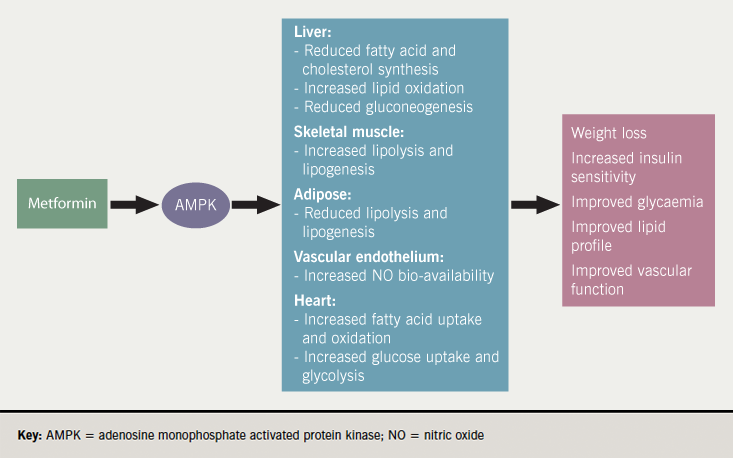
Metformin does not undergo significant metabolism and is excreted renally.
Dosing
Metformin is taken orally one or twice daily to a maximum of 1 g twice daily.
Adverse effects and safety
Metformin causes gastrointestinal (GI) upset such as nausea and diarrhoea in up to 25% of patients. These effects may be minimised, in part, by taking metformin with food, slow titration and prolonged release formulations.
B12 deficiency has been reported in up to 30% of those taking metformin. The American Diabetes Association (ADA) recommends monitoring of B12 in patients taking metformin.2
Metformin has been associated with lactic acidosis although the evidence for this is sparse. Metformin-associated lactic acidosis is more common in states of hypoperfusion such as decompensated heart failure, sepsis and acute myocardial infarction (MI) and should be avoided in these conditions.
Use in cardiovascular disease (CVD)
The long-term benefits of metformin in CVD were demonstrated by the UK Prospective Diabetes Study (UKPDS) in 1998.3 This trial showed that metformin had a similar impact on glycaemia compared to sulphonylureas and insulin but had a greater risk reduction in diabetes-related death and MI (see module 1 for more information).
Data from recent trials and meta-analyses have failed to show evidence in support of its use in CVD prevention, however, unlike some of the newer agents.
Use in chronic kidney disease (CKD)
Metformin is predominantly excreted by the kidneys. Its half-life and clearance are increased in renal impairment and it should be avoided when estimated glomerular filtration rate (eGFR) is below 30mL/min/1.73 m2 and used with caution between 30–45ml/min.
2. Sulfonylureas
Sulfonylureas remain one of the most commonly prescribed drugs for the management of type 2 diabetes. They are typically classified into the newer second-generation drugs (e.g. gliclazide, glimepiride and glipizide) and the older first-generation drugs (e.g. tolazamide and tolbutamide), which are no longer used. Each class varies in its rate of absorption, duration of action, metabolism and excretion and target site on the beta receptor. They require residual beta cell function in order to exert their effects.4
Sulfonylureas bring about rapid control of hyperglycaemia and lower HbA1c by 1–2% (11–22mmol/mol).
However, they carry the risk of hypoglycaemia and cause weight gain, which is often undesirable in a patient with type 2 diabetes. With the exception of insulin, SUs have the biggest risk of hypoglycaemia amongst all agents used to lower blood glucose.
Pharmacology
Sulfonylureas bind to the sulfonylurea receptor (SUR) on pancreatic beta cells stimulating an influx of calcium and subsequent release of insulin (figure 24).
They are extensively metabolised by the liver. Up to 60–70% of metabolites are renally excreted and the remainder is excreted in the bile.
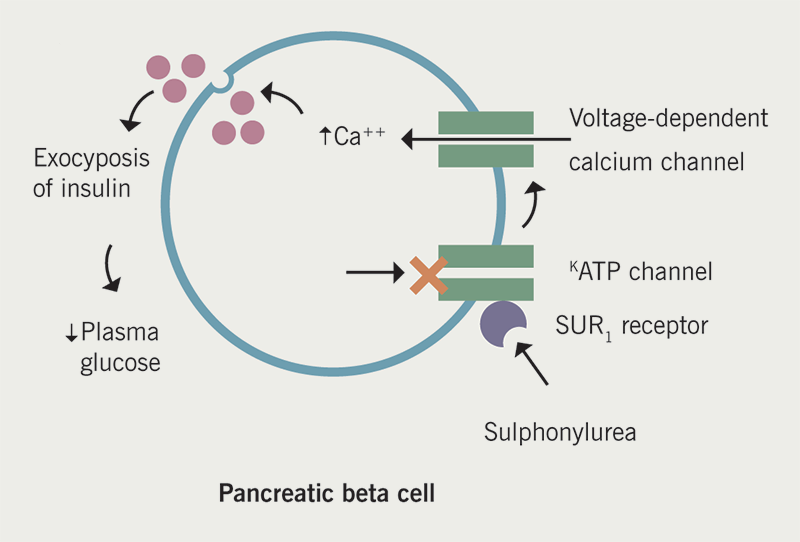
Dosing
Gliclazide is taken orally. Dosing begins at 40 mg once daily and can be increased to a maximum of 160 mg twice daily. Modified-release preparations are also available.
Adverse effects and safety
The main adverse effects associated with this class of drug are weight gain and hypoglycaemia. The risk of hypoglycaemia is increased in the elderly, renal impairment and low carbohydrate intake.
Use in CKD
The half-life of this class of drug is increased in renal impairment, leading to an increased risk of hypoglycaemia. This risk is less with gliclazide, which is predominantly metabolised by the liver.
3. Meglitinides
Like sulfonylureas, meglitinides are taken orally and stimulate insulin secretion from the pancreatic beta cells but act at a separate binding site. Drugs in this class include repaglinide and nateglinide. They also require residual beta cell function in order to exert their hypoglycaemic effects and act in a glucose dependent manner.5
They have a faster onset and shorter half-life compared to sulfonylureas and are typically used to lower postprandial blood glucose. They are not widely used due to the multiple dosing requirement.
Megalitinides reduce HbA1c by 0.5–1.5%, cause weight gain and carry a high risk of hypoglycaemia.
Pharmacology
Meglitinides bind to a separate site on the sulfonylurea receptor on the beta-cell membrane to inhibit ATP-sensitive potassium channels and thereby stimulate insulin secretion. They are predominantly metabolised by the liver and excreted in bile.
Dosing
Nateglinide is commenced at 60 mg, up to three times a day prior to food, and can be increased to 180 mg per dose.
Repaglinide is commenced at 500 μg prior to main meals and increased to a maximum of 4 mg per dose and a total of 16 mg per day.
Adverse effects and safety
Like sulfonylureas, metaglinides are associated with weight gain and hypoglycaemia. Nateglinide can be associated with upper respiratory tract infections.
Use in CVD
There are no cardiovascular outcome trials (CVOTs) with metaglinides in people with diabetes. The NAVIGATOR (Nateglinide and Valsartan in Impaired Glucose Tolerance Outcomes Research) study, an investigator initiated CVOT, found no difference between nateglinide and placebo with respect to cardiovascular outcomes in patients with impaired glucose tolerance.6
Use in CKD
Metaglinides have not been extensively studied in the CKD population but are considered safe in mild-to-moderate CKD. Repaglinide can accumulate in advanced CKD but is not associated with an increased risk of hypoglycaemia or toxicity.
4. Thiazolidinediones
This class of drugs are insulin sensitisers. Pioglitazone is the only agent in this class. Trosiglitazone was withdrawn in 2000 following reports of hepatotoxicity and rosiglitazone was withdrawn from the market in 2010 following a meta-analysis which suggested an 43% increase in myocardial infarction.7 Thiazolidinediones have largely fallen out of favour in recent years due to their association with bladder cancer and heart failure and with the development of alternative hypoglycaemic agents.
Pioglitazone reduces HbA1c by approximately 0.6–1.2%, can cause weight gain and has a low risk of hypoglycaemia.
Pharmacology
Thiazolidinediones are agonists of the peroxisome-proliferator-activated-gamma (PPAR-γ) receptor widely expressed in adipose as well as skeletal muscle, liver and pancreatic beta cells. PPAR-γ modulates transcription of genes involved in lipid and glucose metabolism. Its activation results in improved insulin sensitivity and promotes lipogenesis, thereby reducing serum fatty acid concentrations and also gluconeogenesis.8 The mechanism of action of thiazolidionediones is outlined in figure 3.9
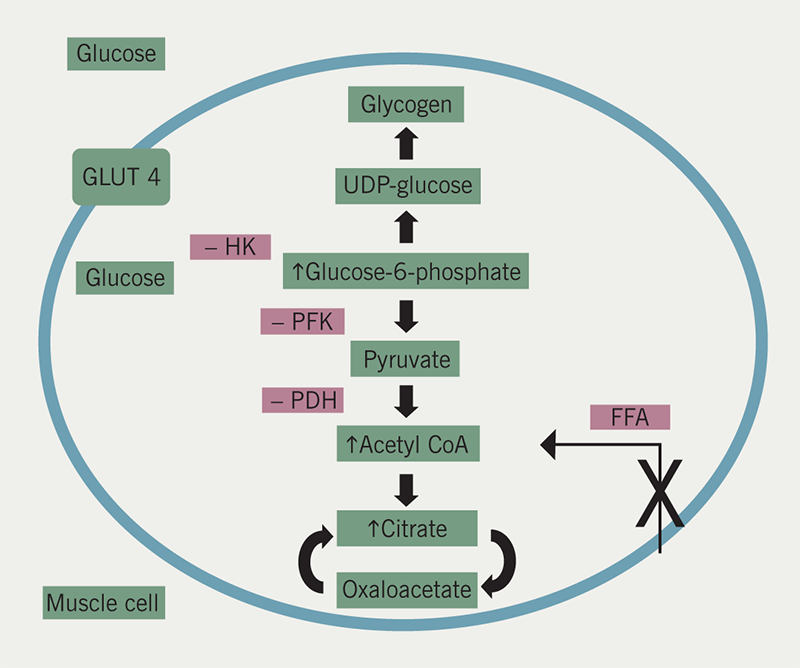
Thiazolidinediones are extensively metabolised by the liver. Up to 30% is renally excreted and the remainder is eliminated via the GI tract in bile and faeces.
Dosing
Pioglitazone is taken orally at 15–45 mg once daily.
Adverse effects and safety
Pioglitazone is associated with an increase in peripheral oedema in up to 7% of patients and in up to 15% of those taking insulin. It is also associated with weight gain of approximately 2–3 kg.
It increases renal sodium retention and should therefore be avoided in patients with heart failure and used with caution in those with risk factors for heart failure.
There is some evidence of an association with bladder cancer and pioglitazone therefore should be avoided in patients with active or a history of bladder cancer.
An increased risk of fracture is reported in patients taking pioglitazone, particularly in postmenopausal women. It is not recommended in patients with a high fracture risk.
Use in CVD
There is evidence of an increased risk of heart failure with pioglitazone10 and it should therefore be avoided in this population.
Use in CKD
No dose adjustment is needed in patients with CKD but pioglitazone should be avoided in patients receiving dialysis.
5. Acarbose
Alpha glucosidase enzyme inhibitors such as acarbose are infrequently used due to their side effects. They can be used as monotherapy or in combination with other agents. When used in patients with impaired glucose tolerance, it can delay progression to diabetes.
Acarbose lowers HbA1c by 0.8–1%, is weight neutral and carries a low risk of hypoglycaemia.
Pharmacology
Acarbose reversibly inhibits the alpha glucosidase enzyme present in the intestinal brush border. This enzyme is responsible for the breakdown of complex sugars into glucose and other monosaccharides. Acarbose therefore results in slowing of carbohydrate absorption and attenuation of post-prandial hyperglycaemia.11 Its mechanism of action is shown in figure 4.11
The activity of alpha glucosidase varies between individuals necessitating dose adjustment according to clinical and adverse effects.
It is minimally absorbed with only 2% reaching the circulation. The remainder is metabolised by the GI tract and excreted in faeces.
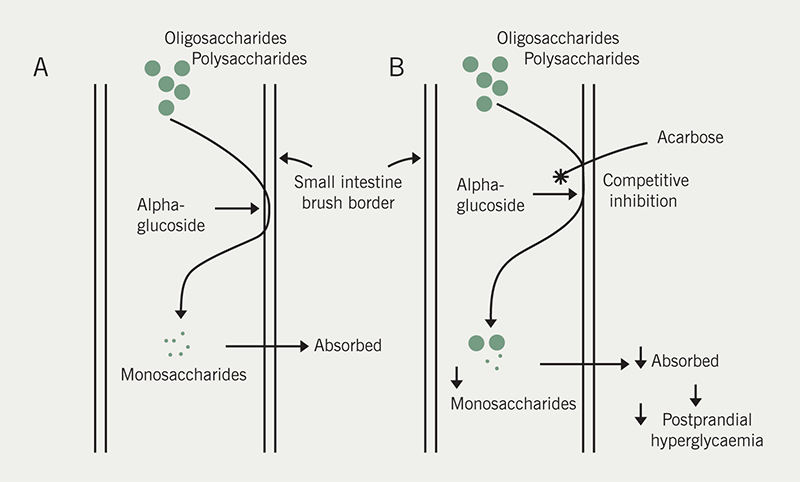
Dosing
Acarbose is taken orally and started at 50 mg once a day. It is gradually increased and can be taken to a maximum of 200 mg three times a day. It should be taken with the first bite of each meal.
Adverse effects
Flatulence, bloating and abdominal discomfort are the most common adverse effects associated with acarbose and occur in up to 30% of individuals. GI upset is related to the amount of carbohydrate consumed and is a consequence of the fermentation of undigested carbohydrate.
Use in CVD
Some studies have suggested beneficial cardiovascular outcomes and improvements in parameters such as endothelial dysfunction, C-peptide, triglycerides, body weight and blood pressure.
However, a recent meta-analysis failed to find support for the use of acarbose in CVD prevention.12
Use in CKD
Although less than 2% of acarbose is excreted by the kidneys, in patients with impaired renal function these levels can be higher. It can be used in grade 3 CKD but should be avoided in grades 4 and 5 CKD due to a lack of information in this population.
6. DPP-4 inhibitors
The dipeptidyl peptidase-4 (DPP-4) inhibitor class of drugs potentiate the incretin effects and includes drugs such as sitagliptin, alogliptin, linagliptin and vildagliptin. The incretin effect is the phenomenon whereby an oral glucose load produces a greater insulin secretory response than the same amount of glucose administered intravenously. This phenomenon is mediated by glucose-dependent releasing polypeptide (GIP) and glucagon-like peptide 1 (GLP-1) which are secreted in response to glucose ingestion and are responsible for stimulating 50-70% of the total insulin secretion in response to glucose. The incretin effect is diminished in patients with type 2 diabetes.13
GLP-1 and GIP are degraded by DPP-4, a step that has been exploited pharmacologically in order to potentiate the incretin effect (see figure 513).
Their effects are modest and DPP-4 inhibitors reduce HbA1c by up to 0.7%. They are weight neutral and have a low risk of hypoglycaemia.

Pharmacology
DPP-4 inhibitors prevent the breakdown of GLP-1 and GIP and increase their systemic concentration. This leads to an increase in insulin secretion and inhibition of glucagon release.
DPP-4 inhibitors do not undergo extensive metabolism and are largely excreted in urine and or via bile.
Dosing
DPP-4 inhibitors are generally taken orally once daily. Table 1 provides prescribing considerations for the available DPP-4 inhibitors.
Table 1. Prescribing considerations for dipeptidyl peptidase-4 (DPP-4) inhibitors14
| Drug | Administration | Excretion | Prescribing |
|---|---|---|---|
| Sitagliptin | Once daily | Renal | Dose reduction in CKD |
| Vildaglitpin | Twice daily | Renal | Dose reduction in CKD LFT monitoring required |
| Saxagliptin | Once daily | Renal | Dose reduction in CKD |
| Linagliptin | Once daily | Bilirary | No dose reduction in CKD |
| Alogliptin | Once daily | Renal | Dose reduction in CKD |
| Key: CKD = chronic kidney disease; LFT = liver function test | |||
Adverse effects and safety
This class of drugs is well tolerated. Nasopharyngitis and skin lesions are the most commonly reported side effects.
Use in CVD
DPP-4 inhibitors appeared to have varying effects on the risk of heart failure. CVOTs with saxagliptin and alogliptin have reported associations with heart failure.15,16 However, this has not been seen in the trials for sitagliptin and linagliptin (see module 3 for more details). The reasons underlying these differences are unclear.
Use in CKD
DPP-4 inhibitors should be used at reduced doses in moderate-to-severe CKD. Only 5% of linagliptin is cleared renally and it can therefore be used at all stages of renal impairment.
7. SGLT2 inhibitors
Sodium-glucose co-transporter 2 (SGLT-2) inhibitors have a novel, insulin independent mechanism of action and promote glycosuria. This class includes canagliflozin, dapagliflozin, ertugliflozin and empagliflozin.
They reduce HbA1c by 0.6–1.2% depending on baseline HbA1c. They are associated with a weight loss of 2–3kg and have modest blood pressure lowering effects. They also have beneficial actions on lipid profile by lowering triglycerides and increasing high-density lipoprotein cholesterol.
Pharmacology
SGLTs are membrane transporters that are responsible for the absorption of glucose in the renal tubules. 90% of filtered glucose is reabsorbed by SGLT2 with the remainder being taken up by SGLT1. By blocking this process, SGLT2 inhibitors reduce the renal absorption of glucose, cause glycosuria and reduce serum glucose concentrations. The net caloric loss of glucose is responsible for their effect on weight. Their impact on blood pressure is a consequence of their natriuretic and diuretic effects (see figure 6).17,18
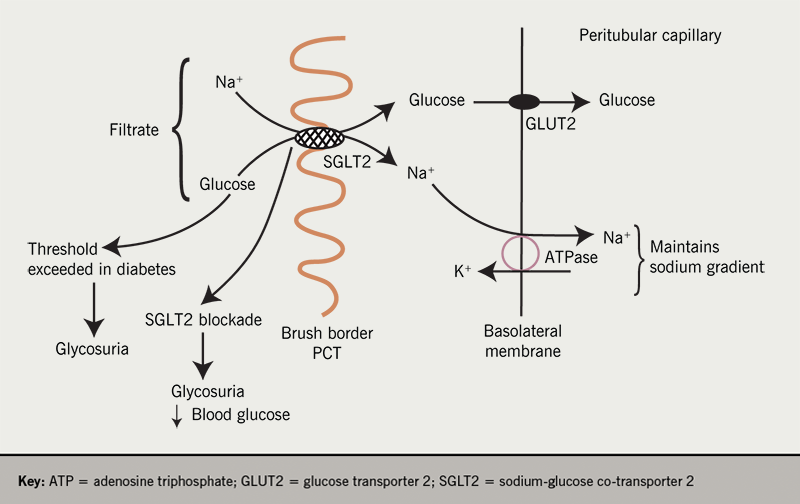
Dosing
This class of drugs are taken orally once daily. Table 2 details some of their prescribing considerations.
Table 2. Prescribing considerations for sodium-glucose co-transporter (SGLT-2) inhibitors
| Drug | Administration | Half life (hours) | Prescribing considerations |
|---|---|---|---|
| Dapagliflozin | Once daily | 17 | Glycaemic therapy: Do not initiate if eGFR <60 Discontinue if eGFR <45 Heart failure: No dose adjustment is required based on renal function Reduce dose in severe hepatic impairment |
| Canagliflozin | Once daily | 12-15 | Glycaemic therapy: eGFR >60 initiate with 100 mg, may increase to 300 mg Diabetic kidney disease: eGFR <60 initiate with 100 mg for should not be initiated if eGFR <30 Avoid in severe hepatic impairment |
| Empagliflozin | Once daily | 10-19 | *Do not initiate if eGFR <60 *Reduce dose if eGFR falls <60 *Discontinue if eGFR falls <45 Avoid severe hepatic impairment |
| Ertugliflozin | Once daily | 17 | Do not initiate if eGFR <60 Discontinue if eGFR falls <45 Avoid in severe hepatic impairment |
| eGFR in ml/min/1.73m2. * Revised licensing guidelines awaited. | |||
Adverse effects and safety
The most common adverse events are mycotic genital and urinary tract infections secondary to glycosuria. Volume depletion and hypotension can also occur.
One of the most important safety concerns is the association of SGLT-2 inhibitors with diabetic ketoacidosis (DKA). Factors which increase this risk include patients with low beta cell reserve, sudden reductions in insulin, intercurrent illness, post-operative period and alcohol excess. They should therefore be used with caution in these groups and patients should be provided with appropriate education.
CANVAS (The Canagliflozin Cardiovascular Assessment Study) found that canagliflozin was associated with a two-fold increased risk of lower limb amputation compared to placebo.18 This risk has not been seen with empagliflozin or dapagliflozin. Further data is required to characterise this relationship.
SLGT-2 inhibitors modulate calcium and phosphate homeostasis. Canagliflozin has been reported to increase fracture risk without affecting bone mineral density.19 This association was not seen with empagliflozin or dapagliflozin. However, there remains a lack of evidence for this association.
Use in CVD
SGLT-2 inhibitors have demonstrated cardiovascular protective effects. While this will be discussed in more detail in module 4, they have shown to reduce hospitalisation from heart failure, reduce CV mortality, non-fatal myocardial infarction and non-fatal stroke. They should be considered for use in all patients with diabetes with or at high risk of CVD.
Dapagliflozin has recently been licensed for the treatment of heart failure in patients with and without diabetes.20 There is no dose adjustment required for patients with mild-to-moderate renal impairment but it should be avoided when eGFR falls below <30ml/min/1.73 m2.
Use in CKD
The beneficial effects of SGLT-2 inhibitors on glycaemia are proportional to glomerular filtration and their efficacy therefore decreases with renal impairment. They are generally not licensed for initiation when eGFR <60ml/min/1.73 m2 and doses should be reduced with declining renal function. Canagliflozin has been approved by the US Food and Drug Administration (FDA) and the European Medicines Agency (EMA) for use in patients with CKD after the CREDENCE (The Canagliflozin and Renal Endpoints in Diabetes with Established Nephropathy Clinical Evaluation) trial demonstrated it slowed renal decline and improved renal outcomes.21
8. GLP-1 receptor agonists

Until recently, the GLP-1 receptor agonists formed a class of injectable non-insulin therapies used in the management of type 2 diabetes. Oral semaglutide has been approved by the FDA and EMA. Their effects are not limited to improving glycaemic control. GLP-1 receptor agonists carry additional benefits, such as weight loss of between 2–8 kg and a modest reduction in blood pressure.
Currently available GLP-1 receptor agonists include exenatide, liraglutide, dulaglutide and semaglutide.
GLP-1 agonists reduce HbA1c by approximately 1% (11 mmol/mol) and have weight lowering effects. They carry a low risk of hypoglycaemia.
Pharmacology
GLP-1 is an incretin hormone released in response to oral glucose intake which stimulates glucose-dependent insulin secretion and suppresses glucagon release. It also reduces gastric emptying, thereby reducing glucose excursions. GLP-1 also reduces gastric emptying, promotes satiety and reduced oral intake via central mechanisms (figure 7).22,23
GLP- 1 receptor agonists replicate the physiological effects of GLP-1 but additionally have structural changes which make them resistant to degradation by the enzyme dipeptidyl peptidase and PK properties which allow once-weekly dosing.

Dosing
With the excretion of oral semaglutide, GLP-1 receptor agonists are given by subcutaneous injection at frequencies which vary from once daily to once weekly.
Both the Scottish Intercollegiate Guidelines Network (SIGN) and the National Institute of Health and Care Excellence (NICE) recommend use of GLP-1 receptor agonists as third-line therapy in patients with a body mass index greater than >30 and 35, respectively.24,25 However, NICE acknowledge that patients with a lower BMI lower may also benefit from this class of drugs if they have obesity-related comorbidities or where the addition of insulin would have significant occupational implications. NICE guidelines recommend continuation of treatment beyond six months if there has been a beneficial response with an HBA1c reduction of 1% (11 mmol/mol) and weight loss of 3% body weight.
Adverse effects and safety
The use of GLP-1 receptor agonists can be limited by nausea and vomiting or abdominal discomfort. This results in approximately 10% of patients discontinuing therapy.
Pharmacovigilance reports suggested an increased risk of pancreatitis and pancreatic cancer. Subsequent meta-analyses have not supported this association but there remains caution with their use in patients with previous pancreatitis.
In animal models, GLP-1 receptor agonists have been found to stimulate thyroid C-cell hyperplasia and increase the risk of medullary thyroid cancer. While no evidence of this has been found in clinical trials, GLP-1 receptor agonists are contraindicated in patients with a history of thyroid cancer.
Use in CVD
Liraglutide, semaglutide, albiglutide and dulaglutide have been shown to reduce CV morbidity and mortality. These effects will be discussed in more detail in module 3. Their beneficial effects are thought, in part, to relate to their favourable actions on blood pressure and lipid profile.
Exenatide and liraglutide have been associated with increases in heart rate (1–2 beats/minute, an effect of uncertain impact on CV outcomes, which requires further investigation.
Use in CKD
GLP-1 receptor agonists can be used in mild renal impairment and use in CKD can vary with different stages of renal disease (see table 3).
Table 3. Prescribing considerations for glucagon like peptide-1 (GLP-1) receptor agonists
| Drug | Administration | Prescribing considerations | |
|---|---|---|---|
| Exenatide | Twice daily, sc Once weekly, sc |
Use with caution in moderate renal impairment (eGFR <30–50) Avoid in severe renal impairment (eGFR<15) |
|
| Liraglutide | Once daily, sc | Most effective in reducing HbA1c and weight Avoid in end-stage renal disease (eGFR <15) Not recommended in severe hepatic impairment |
|
| Dulaglutide | Once weekly, sc | Avoid in end-stage renal disease (eGFR <15) No dose adjustment in hepatic impairment |
|
| Semaglutide | Once weekly, sc Once daily, oral |
Oral preparation should be taken on an empty stomach Avoid in end-stage renal disease (eGFR <15) Avoid in severe hepatic impairment |
|
| Lixisenatide | Once daily | Avoid in severe renal impairment (eGFR <30) No dose adjustment in hepatic impairment |
|
| eGFR quoted in ml/min/1.73m2; sc= subcutaneously | |||
GLP-1 receptor agonists have also demonstrated favourable effects on renal outcomes.26 The renoprotective mechanisms have not been fully elucidated but are thought to involve natriuresis and reductions in oxidative stress, inflammation and fibrosis.
9. Insulin
Insulin is a peptide hormone that was first isolated in 1922. Its production has evolved since and commercial insulin is now produced by recombinant DNA technology. There are many different insulin analogues each with different pharmacodynamic and pharmacokinetic profiles.27
Many types of insulin are available and they are commonly classified by onset of action into basal insulin (long acting), prandial insulin (short acting) and mixed insulin (mixture of long and short acting).
In type 2 diabetes, insulin is used when glycaemic targets are not met with other agents, in the presence of moderate to severe CKD and in cases of beta cell failure.
While insulin rapidly improves HbA1c, it causes weight gain and has a high risk of hypoglycaemia.
Pharmacology
Insulin has a variety of metabolic effects mediated by the insulin receptor, a tyrosine kinase receptor which then activates several downstream signalling pathways.
It stimulates the uptake of glucose and amino acids into muscle and adipose. It also stimulated synthesis of glycogen, fatty acids and protein. In the liver, it inhibits gluconeogenesis.27 These effects are shown in figure 8.27
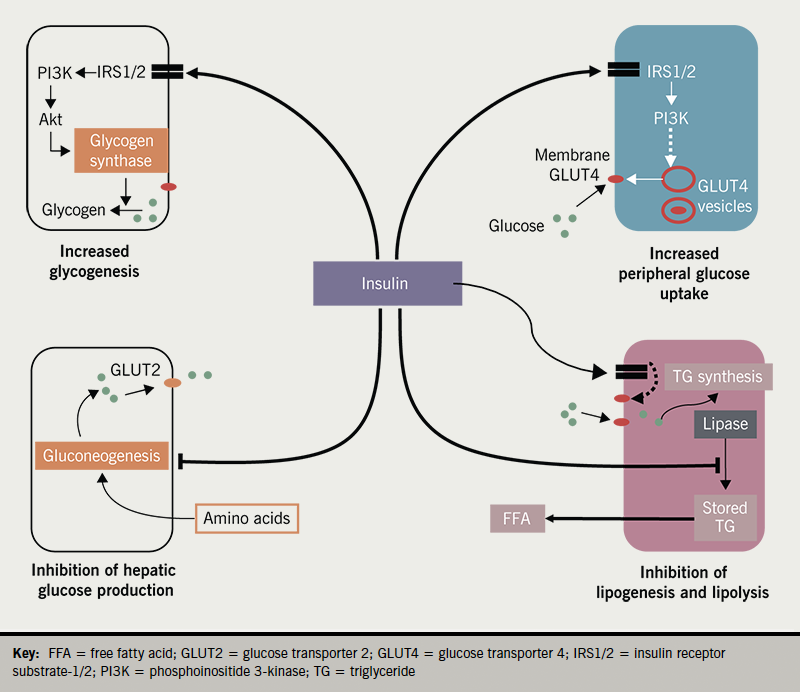
Insulin must be administered subcutaneously or intravenously. Insulin is predominately excreted by the kidneys and renal impairment results in an increase in its half-life.
Dosing
Dosing is dependent on the type of insulin being administered, dosing regimen and capillary blood glucose levels.
Use in CVD
Insulin has been associated with an increased risk of CV events in several long-term clinical trials. Whether this association is causal it not yet known but it is likely to be associated with the risk of hypoglycaemia and insulin’s unfavourable metabolic effects, such as weight gain and dyslipidaemia. It is therefore recommended that, where possible, alternative agents are used in preference to insulin.
Use in CKD
Insulin can be used at all stages of renal impairment. However, caution should be exercised with declining renal function as the clearance of insulin is reduced and there can be an increased risk of hypoglycaemia.
Summary
There are several classes of anti-diabetic drugs used in the management of type 2 diabetes. Their impact on HbA1c and side effect profile vary, and many have cardioprotective benefits. A summary of each class and general considerations with regards the presence of CVD or CKD is given in table 4.
Table 4. Drug classes and general prescribing recommendations according to cardiovascular disease (CVD) or chronic kidney disease (CKD)
| Drug/class | Use in CVD | Use in CKD | |
|---|---|---|---|
| Metformin | Uncertain CVD benefit | Avoid when eGFR <30 | |
| Sulfonylureas | Possible increase in CV risk, consider alternatives | Caution in moderate-severe CKD | |
| Meglitinides | No evidence available | Caution in moderate-severe CKD | |
| Acarbose | Insufficient evidence | Avoid in severe CKD | |
| Thiazolidinediones | Avoid in heart failure | Safe at all stages of CKD Avoid in dialysis |
|
| DPP-4 inhibitors | No CV benefit demonstrated avoid in heart failure | Dose reductions required with CKD (except linagliptin) | |
| SGLT2 inhibitors | Cardioprotective effects | Renoprotective effects can initiate canagliflozin if eGFR <60 | |
| GLP-1 receptor agonists | Cardioprotective effect | Dose adjustments may be required in CKD according to individual drug | |
| Insulin | Increased CV risk | Safe at all stages of CKD | |
| eGFR quoted in ml/min/1.73m2 | |||
close window and return to take test
References
1. Boyle, J, McKay A, Fisher M. Drugs for diabetes: part 1 metformin. Br J Cardiol 2010;17:231-234. https://bjcardio.co.uk/2010/09/drugs-for-diabetes-part-1-metformin/
2. American Diabetes Association. Standards of medical care in diabetes – 2017: summary of revisions. Diabetes Care 2017;40(suppl 1):S4–S5. https://doi.org/10.2337/dc17-S003
3. UK Prospective Diabetes Study (UKPDS) Group. Effect of intensive blood-glucose control with metformin on complications in overweight patients with type 2 diabetes (UKPDS 34). Lancet 1998;352:854-65. https://doi.org/10.1016/S0140-6736(98)07037-8
4. Smith C, Fisher M, McKay G. Drugs for diabetes: part 2 sulphonylureas. Br J Cardiol 2010;17:279–82. https://bjcardio.co.uk/2010/11/drugs-for-diabetes-part-2-sulphonylureas/
5. Guardado-Mendoza R, Prioletta A, Jiménez-Ceja LM, et al. The role of nateglinide and repaglinide, derivatives of meglitinide, in the treatment of type 2 diabetes mellitus. Arch Med Sci 2013;9:936–43. https://doi.org/10.5114/aoms.2013.34991
6. NAVIGATOR Study Group. Effect of nateglinide on the incidence of diabetes and cardiovascular events. N Engl J Med 2010;362:1463–76. https://doi.org/10.1056/NEJMoa1001122
7. Nissen SE, Wolski K. Effect of rosiglitazone on the risk of myocardial infarction and death from cardiovascular causes. N Engl J Med 2007;356(24):2457–71. https://doi.org/10.1056/NEJMoa072761
8. Johns E, McKay G Fisher M. Glitazones (thiazolidinediones) Br J Cardiol 2017;24:3. http://doi.org/10.5837/bjc.2017.018
9. McGrane, Fisher M, McKay G. Drugs for diabetes: part 3 thiazolidinediones. Br J Cardiol 2011;18:24–7. https://bjcardio.co.uk/2011/02/drugs-for-diabetes-part-3-thiazolidinediones/
10. Lincoff AM, Wolski K, Nicholls S. Pioglitazone and risk of cardiovascular events in patients with type 2 diabetes JAMA 2007;298:1180–8. http://doi.org/10.1001/jama.298.10.1180
11. Arungarinathan G, McKay G Fisher M. Drugs for diabetes: part 4 acarbose. B J Cardiol 2011;18:78–81. https://bjcardio.co.uk/2011/04/drugs-for-diabetes-part-4-acarbose/
12. Coleman RL, Scott CAB, Lang Z, et al. Meta-analysis of the impact of alpha-glucosidase inhibitors on incident diabetes and cardiovascular outcomes. Cardiovasc Diabetol 2019;18(1):135. http://doi.org/10.1186/s12933-019-0933-y
13. McDougall C, McKay G Fisher M. Drugs for diabetes: part 5 DPP4 inhibitors. Br J Cardiol 2011;18:130–2. https://bjcardio.co.uk/2011/06/drugs-for-diabetes-part-5-dpp-4-inhibitors/
14. Johns E, McKay G, Fisher M. DPP-4 inhibitors Br J Cardiol 2017;24:Č(1). http://doi.org/10.5837/bjc.2017.001
15. Scirica BM, Bhatt DL, Braunwald E, et al. Saxagliptin and cardiovascular outcomes in patients with type 2 diabetes mellitus. N Engl J Med 2013;369:1317–26. http://doi.org/10.1056/NEJMoa1307684
16. Zannad F, Cannon CP, Cushman WC, et al. Heart failure and mortality outcomes in patients with type 2 diabetes taking alogliptin versus placebo in EXAMINE: a multicentre, randomised, double-blind trial. Lancet 2015;385:2067–76. http://doi.org/10.1016/S0140-6736(14)62225-X
17. MacEwan A, McKay GA, Fisher M. Drugs for diabetes: part 8 SGLT2 inhibitors. Br J Cardiol 2012;19:26–9. http://doi.org/10.5837/bjc.2012.005
18. Johns E, McKay G, Fisher M. SGLT-2 inhibitors Br J Cardiol 2017;24:68–71. http://doi.org/10.5837/bjc.2017.010
19. Neal B, Perkovic V, Mahaffey KW, et al. Canagliflozin and cardiovascular and renal events in type 2 diabetes. N Engl J Med 2017;377:644–57. http://doi.org/10.1056/NEJMoa1611925
20. McMurray JJV, Solomon SD, Inzucchi SE, et al. Dapagliflozin in patients with heart failure and reduced ejection fraction. N Engl J Med 2019;381:1995–2008. http://doi.org/10.1056/NEJMoa1911303
21. Perkovic V, Jardine MJ, Neal B, et al. Canagliflozin and renal uutcomes in type 2 diabetes and nephropathy. N Engl J Med 2019;380:2295–306. http://doi.org/10.1056/NEJMoa1811744
22. Johns E, McKay G, Fisher M. GLP-1 agonists Br J Cardiol 2017;24:152–5. http://doi.org/10.5837/bjc.2017.030
23. McDougall C, McKay GA, Fisher M. Drugs for diabetes: part 6 GLP-1 receptor agonists. Br J Cardiol 2011;18:167–9. https://bjcardio.co.uk/2011/08/drugs-for-diabetes-part-6-glp-1-receptor-agonists/
24. Scottish Intercollegiate Guidelines Network (SIGN). SIGN 154: Pharmacological management of glycaemic control in people with type 2 diabetes. SIGN, 2017. https://www.sign.ac.uk/our-guidelines/pharmacological-management-of-glycaemic-control-in-people-with-type-2-diabetes/ (last accessed 4th January 2021).
25. National Insitute for Health and Care Excellence (NICE). Type 2 diabetes in adults: management. NICE guideline (NG28), December 2015, revised December 2020. London: NICE. https://www.nice.org.uk/guidance/ng28 (last accessed 4th January 2021).
26. Kawanami D, Takashi Y. GLP-1 receptor agonists in diabetic kidney disease: from Clinical outcomes to mechanisms. Front Pharmacol 2020;11:967. https://doi.org/10.3389/fphar.2020.00967
27. Barwell N, McKay G, Fisher M Drugs for diabetes: part 7 insulin. Br J Cardiol 2011;18:224–8. https://doi.org/10.5837/bjc.2011.003

All rights reserved. No part of this programme may be reproduced, stored in a retrieval system, or transmitted in any form or by any means, electronic, mechanical, photocopying, recording or otherwise, without the prior permission of the publishers, Medinews (Cardiology) Limited.
It shall not, by way of trade or otherwise, be lent, re-sold, hired or otherwise circulated without the publisher’s prior consent.
Medical knowledge is constantly changing. As new information becomes available, changes in treatment, procedures, equipment and the use of drugs becomes necessary. The editors/authors/contributors and the publishers have taken care to ensure that the information given in this text is accurate and up to date. Readers are strongly advised to confirm that the information, especially with regard to drug usage, complies with the latest legislation and standards of practice.
Healthcare professionals should consult up-to-date Prescribing Information and the full Summary of Product Characteristics available from the manufacturers before prescribing any product. Medinews (Cardiology) Limited cannot accept responsibility for any errors in prescribing which may occur.